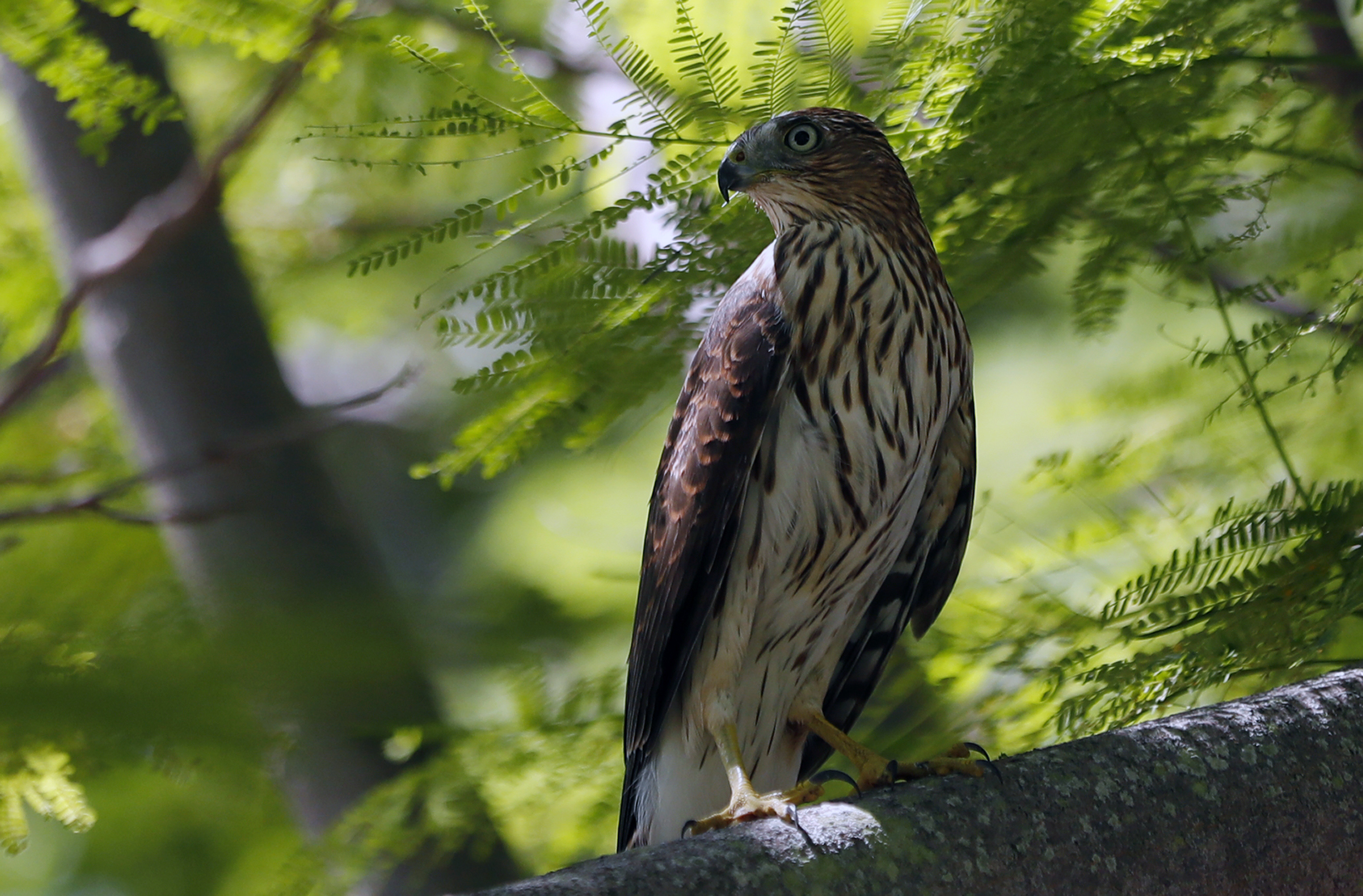
An adult Cooper's hawk. (AP Photo/Wilfredo Lee)
Wilfredo Lee / AP
The calls flooded into Blue Mountain Wildlife first thing in the morning Monday, June 28 — dozens of baby hawks, desperate to escape the blast of early summer heat, bailed from their nests and plummeted to the ground.
Calls poured in day after day as temperatures pushed beyond 110 degrees across Eastern Oregon. In her 30 years as director of the wildlife rehabilitation center outside of Pendleton, Lynn Tompkins had not seen anything like it.
"They had no choice," Tompkins, 68, told the East Oregonian. "It was just too bloody hot to survive."
In all, the center took in nearly 50 nestling Swainson’s and Cooper’s hawks after they leaped from their nests in the extreme heat wave that baked the Pacific Northwest last week. Thirteen of the raptors suffered injuries severe enough they had to be euthanized.
“We knew the temperature was going to spike beforehand, and we assumed we might get a few more calls,” said Trisha Marquez, a volunteer who fielded the calls and who is Tompkins’ niece. “But we did not expect this at all.”
Blue Mountain Wildlife lodged 157 more birds compared to the same day last year. The influx was more than the small staff could handle. They hardly had the space to put them all, and eventually, they asked people to turn on their sprinklers and hoses and set out pans of water for less-injured birds to cool themselves down.
Tompkins said they will typically see a few injured birds who display this sort of behavior in heat waves around July or August. But this year, with the heat arriving earlier and surging higher, it caught the babies right in their nesting period.
“The conditions were just right, or wrong,” Tompkins said, adding, “When your normal body temperature is like 100, and it’s 115, you have no way of moderating the temperature except for getting out of there.”
Birds die across PNW amid heat wave
The birds came from across the region, including Southeastern Washington, as wildlife center’s facility in the Tri-Cities took in more than 70, Tompkins said.
And it’s not just happening here. A rehabilitation center in Delta, British Columbia, saw a similar uptick amid the heat wave last week. The center has about 140 more birds than last year at this time, and many babies that flung themselves from their nests didn’t make it, a Vancouver news station reported.
In Seattle, state officials began monitoring a colony of Caspian terns last week after dozens of premature seabirds fled their rooftop nests as temperatures reached 108 degrees. Too young to fly, they fell to their death.
Marquez said events such as the heat wave can have a population-wide effect.
“Usually, rehabbers make a difference for one bird at a time,” Marquez said. “Overall, we can have an impact, but this is a whole generation of a species of bird.”
A growing body of research from experts around the world suggests as the planet warms due to climate change, species will disappear at an accelerating rate. Some studies suggest the planet has entered its sixth mass extinction of wildlife.
An analysis by scientists from prominent universities across the world, published in the journal Proceedings of the National Academy of Sciences in 2020, found more than 500 species of land animals are on the brink of extinction and likely will die off within 20 years. That will have a domino effect, the research shows, with interdependent species dying one after another, causing extinction rates to accelerate.
Rehabilitation at work
The heat wave and similar events are what empower Marquez and the volunteers and interns to help out at the wildlife center. Last week, Marquez personally set up nine large sprinklers to keep birds cool. The days stretch from early mornings to late evening, and Tompkins added they are typically eating dinner at 10 p.m. these days.
Volunteers last week met at various checkpoints, from Umatilla to Walla Walla, delivering six to eight birds at a time in boxes before they were brought to the wildlife center, where they are fed and prepared for release.
The premature birds now sit in cages stacked one on top of the other at the center. It’s a cluttered but highly functional facility in a yellow double-wide manufactured home on the rolling blonde foothills of the Blue Mountains between Pendleton and Pilot Rock. Inside, volunteers and an intern take measurements and jot down notes while scampering around at least four dogs in tight passageways that smell dankly of birds and feed.
Tompkins founded the wildlife center with her husband, who died last March, in 1990. Since then, the facility has grown, now housing a wide array of birds that include eagles, owls, hawks and smaller birds. It also is an educational facility for youths to learn about local wildlife.
Tompkins, an energetic director constantly thinking of what’s next, said the rest of the baby hawks likely will survive for release. For now, she’s just worried about what the feed bill will be, as the babies are voracious eaters.
“What I always tell people is, if you can euthanize an animal and it doesn’t matter, you’ve been doing this too long,” she said, adding, “We were exhausted, but we couldn’t stop every day until we had dealt with everything we could. It wasn’t a fun job, but it had to be done, so we did it.”
Marquez, who came to the wildlife center to help Tompkins after she had hip surgery nearly two months ago, said even though last week was challenging, she found inspiration.
“I’ve been impressed with the amount of people who have called in, caring about the wildlife,” she said. “That gives me a bit of hope. There are caring people who wanted to do something to help and wanted to call in for whatever bird they saw.”

